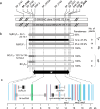QTL analysis of femaleness in monoecious spinach and fine mapping of a major QTL using an updated version of chromosome-scale pseudomolecules
- PMID: 38394294
- PMCID: PMC10890751
- DOI: 10.1371/journal.pone.0296675
QTL analysis of femaleness in monoecious spinach and fine mapping of a major QTL using an updated version of chromosome-scale pseudomolecules
Abstract
Although spinach is predominantly dioecious, monoecious plants with varying proportions of female and male flowers are also present. Recently, monoecious inbred lines with highly female and male conditions have been preferentially used as parents for F1-hybrids, rather than dioecious lines. Accordingly, identifying the loci for monoecism is an important issue for spinach breeding. We here used long-read sequencing and Hi-C technology to construct SOL_r2.0_pseudomolecule, a set of six pseudomolecules of spinach chromosomes (total length: 879.2 Mb; BUSCO complete 97.0%) that are longer and more genetically complete than our previous version of pseudomolecules (688.0 Mb; 81.5%). Three QTLs, qFem2.1, qFem3.1, and qFem6.1, responsible for monoecism were mapped to SOL_r2.0_pseudomolecule. qFem3.1 had the highest LOD score and corresponded to the M locus, which was previously identified as a determinant of monoecious expression, by genetic analysis of progeny from female and monoecious plants. The other QTLs were shown to modulate the ratio of female to male flowers in monoecious plants harboring a dominant allele of the M gene. Our findings will enable breeders to efficiently produce highly female- and male-monoecious parental lines for F1-hybrids by pyramiding the three QTLs. Through fine-mapping, we narrowed the candidate region for the M locus to a 19.5 kb interval containing three protein-coding genes and one long non-coding RNA gene. Among them, only RADIALIS-like-2a showed a higher expression in the reproductive organs, suggesting that it might play a role in reproductive organogenesis. However, there is no evidence that it is involved in the regulation of stamen and pistil initiation, which are directly related to the floral sex differentiation system in spinach. Given that auxin is involved in reproductive organ formation in many plant species, genes related to auxin transport/response, in addition to floral organ formation, were identified as candidates for regulators of floral sex-differentiation from qFem2.1 and qFem6.1.
Copyright: © 2024 Yamano et al. This is an open access article distributed under the terms of the Creative Commons Attribution License, which permits unrestricted use, distribution, and reproduction in any medium, provided the original author and source are credited.
Conflict of interest statement
The authors have declared that no competing interests exist.
Figures




Similar articles
-
Molecular evidence that the genes for dioecism and monoecism in Spinacia oleracea L. are located at different loci in a chromosomal region.Heredity (Edinb). 2014 Mar;112(3):317-24. doi: 10.1038/hdy.2013.112. Epub 2013 Oct 30. Heredity (Edinb). 2014. PMID: 24169648 Free PMC article.
-
Comparison of Spinach Sex Chromosomes with Sugar Beet Autosomes Reveals Extensive Synteny and Low Recombination at the Male-Determining Locus.J Hered. 2016;107(7):679-685. doi: 10.1093/jhered/esw055. Epub 2016 Aug 25. J Hered. 2016. PMID: 27563071
-
Gene Regulatory Network Controlling Flower Development in Spinach (Spinacia oleracea L.).Int J Mol Sci. 2024 Jun 1;25(11):6127. doi: 10.3390/ijms25116127. Int J Mol Sci. 2024. PMID: 38892313 Free PMC article.
-
Mapping of the genes for dioecism and monoecism in Spinacia oleracea L.: evidence that both genes are closely linked.Plant Cell Rep. 2011 Jun;30(6):965-71. doi: 10.1007/s00299-010-0998-2. Epub 2011 Feb 8. Plant Cell Rep. 2011. PMID: 21301852
-
The Quest for Molecular Regulation Underlying Unisexual Flower Development.Front Plant Sci. 2016 Feb 19;7:160. doi: 10.3389/fpls.2016.00160. eCollection 2016. Front Plant Sci. 2016. PMID: 26925078 Free PMC article. Review.
Cited by
-
Characterization of genetic resistance to cucumber mosaic virus (CMV) in spinach (Spinacia oleracea L.).BMC Res Notes. 2024 Nov 12;17(1):335. doi: 10.1186/s13104-024-06987-2. BMC Res Notes. 2024. PMID: 39533390 Free PMC article.
References
-
- Morelock TE, Correll JC. Spinach. In: Tomas JP, Nuez F, editors. Vegetables I (Handbook of Plant Breeding). New York: Springer; 2008. p. 189–218.
-
- FAOSTAT Statistics Database [Internet]. Food and Agriculture Organization of the United Nations. 2023. Available from: https://www.fao.org/faostat/en/#home.
-
- Onodera Y, Yonaha I, Niikura S, Yamazaki S, Mikami T. Monoecy and gynomonoecy in Spinacia oleracea L.: Morphological and genetic analyses. Scientia Horticulturae. 2008;118(3):266–9. doi: 10.1016/j.scienta.2008.06.008 ISI:000259656800014. - DOI
-
- Janick J. Hybrids in horticultural crops. In: Lamkey K, R., Staub J, E., editors. Concepts and breeding of heterosis in crop plants. Crop Science Society of America Special Publication: Crop Scinece Society of America; 1998. p. 45–56.
-
- van der Vossen H, A., M. Spinacia oleracea L. In: Grubben G, J., H., Denton O, A., editors. PROTA 2: Vegetables/Légumes. Wageningen, Netherlands: PROTA; 2004.
MeSH terms
Substances
LinkOut - more resources
Full Text Sources
Miscellaneous

